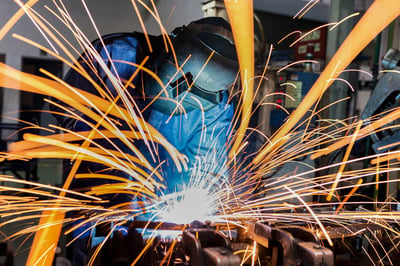Naimor, Inc. has extensive experience providing value added metal fabrication services, including hardware insertion and welding. While CNC routers, laser and punches can cut metal, there is more to the metal fabrication process than just cutting and forming parts.
Hardware Insertion
Many fabricated metal parts require the attachment of specialized tooling such as PEM fasteners, studs, or standoffs to fulfill their purpose. Naimor, Inc. utilizes CNC programmable hardware insertion machinery and equipment to automate the installation of almost any size nut, stud, standoff, or fastener. This equipment and technology helps speed up the insertion process, saving time and labor and minimizing the risk of missing or incorrect hardware.
Naimor staff provides an important resource to assist and support our client’s assessment and determination of the most appropriate fastener hardware for the application and need. We offer hardware insertion services with high tonnage and wide throat depth, helping our clients stay competitive in a broad spectrum of markets and industries.

A Haeger 824 Plus Insertion System allows us to provide fast insertion services accurately. Our system includes a Positive Stop Cylinder, designed for use with soft materials such as PC boards, plastics, fiberglass and aluminum, allowing PEMS, studs or fasteners to be inserted without crushing or deforming the part. The Positive Stop facilitates insertion in parts where pressures as low as 50 lbs may be needed.
Auto Feeding is three times quicker than manual insertion, allowing us to orient and feed up to 2,000 fasteners per hour. The 824 Plus is accurate and allows the operator to apply full tonnage at any point in the stroke. Faster ram speed increases productivity and reduces part cost.
With hardware insertion service, you can:
- Increase production
- Reduce manual labor
- Improve quality through technology
Countersinking
The Naimor team goes the extra mile to assists our customers in design consistency and quality improvements. Countersinking is a method of fabrication that creates a conical hole to allow the insertion of a rivet, bolt, or fastening device. The fastening device can then sit flush with the surface of the sheet metal.
The benefits of countersinking include improved appearance of the part and the elimination of raised screw heads that can snag on clothes or skin.
While thinner gauge metal sheets won’t often be countersunk, there are a few guidelines to try and follow on thicker sheets to preserve the strength of the material and prevent deformation when forming.
- The distance between two countersinks should be kept to at least 8 times the material thickness.
- To ensure strength, the distance between a countersink’s edge and the edge of the material should be 4 times the material thickness.
- There should be at least 50% contact between the fastener and the surface of the countersink.
- To prevent any deformation of the hole, the edge of the countersink should be at least 3 times the material thickness from the tangent point of the bend.
Welding
Many of the parts and assemblies that we manufacture are supported by welds or welded structures. Our WABO certified welders have the expertise and experience to know what welding method will result in the strongest, most reliable bond for any given application.
Putting the pieces together starts with fit-up. Each piece of the assembly is held in position and with clamps as needed, If possible, we will also design parts with notches so that they are easily aligned by the welder, which increases both accuracy and strength. Then tack welds are made to hold everything together. Only then are the long welds made that join the pieces together.
Naimor uses a variety of arc welding equipment including metal inert gas (MIG), tungsten inert gas (TIG) and spot welders. The major difference between MIG and TIG welding is that MIG welding uses a continuously feeding spool of welding wire that quickly burns, melts, and fuses the two metals together. You can MIG or “wire weld” a variety of materials such as mild steel, stainless steel and aluminum. A range of material thicknesses can be welded from thin gauge sheet metal right up to heavier structural plates.
TIG welding, on the other hand, very slowly and delicately feeds long welding rods. TIG welding is more commonly used for thinner fine gauge materials which requires more skill. Items that are made with this process are things like kitchen sinks and tool boxes.
There are a few guidelines to try and follow when designing metal parts needing welding:
- Welding by hand should be restricted to gauges thicker than 20 gauge.
- Spot welding should be used for joining equally thick surfaces.
- Welded joints should be designed with as tight of tolerances as possible to remove the need for a welder to add wire.
Conclusion
Not every client or job needs welding. Depending on the final application, riveting, screwing or bonding might be more appropriate, and is easier to replace. All welds can be cleaned up by grinding and polishing, and can ultimately be made to look like a solid piece of metal.
At Naimor, all metal fabrication processes can be handled in house – from raw material to finished part – allowing for scalability from prototype to production run. Find out how Naimor’s automation and fast delivery can get you custom metal parts on schedule and budget.






